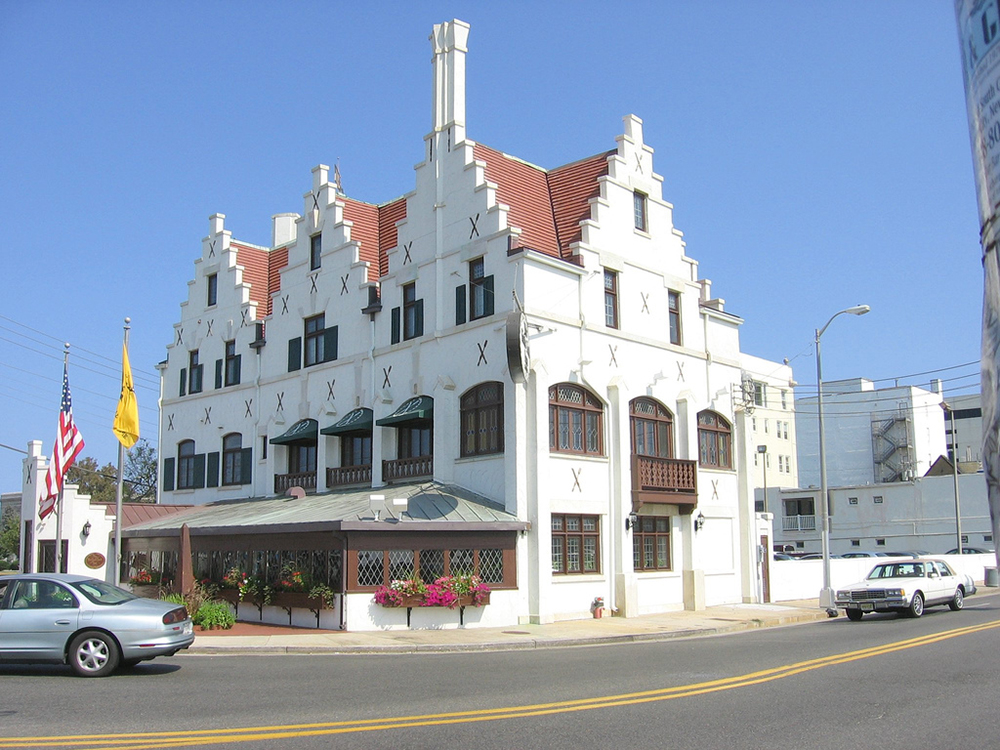The Layers of Local History
A Trip Through the Past Down the AC Boardwalk
By Levi Fox
The most popular excursions offered by Jersey Shore Tours are without doubt walking tours of the Atlantic City Boardwalk, especially the Beaches and Buildings Tour that begins on the Boardwalk at Albany Avenue, and the Boardwalk Heritage Tour that picks up at JFK Plaza across from Boardwalk Hall. While the Beaches and Buildings Tour includes a stroll along the strand, and a discussion of beach birds, it mostly focuses on the histories of the structures that are visible along the south end of the Boardwalk. While the sign outside, and the history offered on their website, suggests the Knife and Fork was initially founded by then-Mayor William Riddle and the so-called Commodore Louis Kuehnle, amongst others, in 1912, some sources suggest Riddle’s mother, one of the first female real-estate magnates in town, had operated an establishment by that name on the site of the current structure as early as 1908. All sources seem to agree that business boomed until the mid-1920s, when a missed kick-back payment in the teeth of Prohibition led to a raid by federal agents and the sale of the site to longtime owners the Latz family.
The Beaches and Buildings Tour goes by several more historic sites, such as the Eldredge Chelsea Fireproof Warehouse built of brick and concrete in 1924. Turning off the boards at the Celebrity Corner Deli allows tourists to appreciate their mural of caricatures completed in 1986, as well as view the 1960s era Malibu Motel Pool and Cabana Club from a better angle, before walking by the displays, public art, and images in the open-air lobby of the thirty-four story Ocean Club Condos that opened in 1984. The Tropicana complex has several historic parts, starting with the Chelsea Tower, which sits on the site of a kosher resort called Teplitzky’s that was replaced by a Howard Johnson’s in the 1970s. Much of the Trop is built on the bones of the Ambassador Hotel, finished in 1919 and site of the famous meeting between Arthur Conan Doyle and Harry Houdini in 1922, though the Trop extends all the way to the site of Nucky Johnson’s two-story cottage on Iowa Avenue. Nucky also famously rented the entire ninth floor of the Ritz-Carlton across the street that dates to 1921 and featured hot and cold running, fresh and salt water.
Nucky was particularly proud of being involved in building Boardwalk Hall, completed in 1929, which was the largest event space in the world when it opened and remains home to the world’s largest musical instrument. The site was home to the 1964 Democratic National Convention, where Mississippi Freedom Democratic Party delegate Fannie Lou Hamer testified about her struggles to register to vote, which led to the building that year of Kennedy Plaza, now the site not only of a bust of JFK but of statues commemorating Miss America and memorializing local laborers. The Boardwalk Heritage Tour continues past the Playground Pier, which was the city’s first concrete pier when it was built by Cap’n John Young in 1906 as the Million Dollar Pier and included the then-world’s-largest ballroom called the Hippodrome, as well as mansion where Young lived at the address One Atlantic Ocean, leading to the site later turning into the Ocean One Mall. The tour also passes by two historic sites that are now part of Bally’s complex: a recreated streetscape of the Warner Theatre that opened in 1929 and became a bowling alley in 1966, and the adaptively reused Dennis Hotel that was completed in 1925 but has a name that dates to 1860.
The Boardwalk Heritage Tour goes by several more historic sites, such as the Irish Pub that dates to the nineteenth century and whose unique architecture inspired the style of the red Monopoly hotels, as well as the nearby First Responders’ Monument honoring police and fire personal who died on 9/11. After stopping at the compass rose in front of Central Pier, which opened as Applegate Pier in 1884, and pointing out Steel Pier, completed in 1898 and home to the famous diving horses as well as a diving bell that can now be found across from the aquarium in Gardner’s Basin, I point out a few of the structures that lie further down the northern end of the Boardwalk, such as the Chalfonte-Haddon Hall Hotel that became Resorts in 1978. I like to end that tour, which–like this column has done–seeks to unearth the layers of local history, by showing visitors the detailed mosaics of the Boardwalk National Bank building that dates to the 1920s, but since the late 1970s has been the home of the Casino Control Commission.
Dr. Levi Fox holds a PhD in History from Temple and teaches at Stockton. Levi is also Secretary of the Somers Point Historical Preservation Commission and President of Jersey Shore Tours






